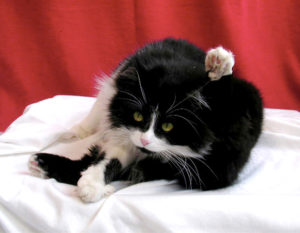We got a new, expensive automatic litter box. One of our cats is just fine with it but the other insists on pooping in the tub now. How can we get her back to using the box?

Imagine you’re a small wild animal. You have your outside territory, where you can do your elimination thing almost anywhere you want. Your average territory is 3 square miles if you’re a male, a mile if you’re female. Since what you leave behind is like email for the rest of the animal world, your messages usually get picked up by whoever needs to read them.
Now imagine you’re no longer wild. You’ve been brought up to be social and enjoy your humans, but you’re expected to live your life in the confines of this thing they call a house. Your humans are in complete charge of where you eliminate, providing the what, where and how for something that’s essential to your survival.

Let’s say your human doesn’t understand this. Since most cats are hardwired for certain behaviors around elimination, all you want is a nice, safe place to do your business, in something that sort of resembles the sand you’d choose if you were outside. How could this possibly go wrong?
Let us count the ways.
- Your human puts the box in a place where you don’t feel safe and can’t relax. Cats are like most of us: they need a little piece and quiet when they have to go. If your box’s location is scary or noisy or around other animals, you’ll find another spot that allows you to settle in and do what you need to do. The fact that it may not be where your human wants you to go is really not even part of the equation when your safety is at risk. Does my cat feel safe? is the first question to ask for solving many cat issues.
- Your human doesn’t give you enough choices. If there’s a cat in the box when another cat needs to go, the competition can force the second cat to go outside the box. A sideways glance can be enough for some cats to feel threatened by another cat and not use that box. Give them good alternatives.
- Your human puts a lid on your box. Some cats feel safer in an enclosed space, but many will feel trapped. Introducing them to a covered box usually works best when they’re kittens. If they refuse to use the covered box, it’s because they feel safer using an open one. Humor them.
- Your human puts stinky stuff in your box. Cats prefer unscented litter, period. Yes, research confirms scented litter is made for people, not cats. Most big litter companies have partnered with chemical companies to lure you in and make life hell for your cats. Think about being right down in that stuff, with no chance to get away when you are at your most vulnerable. Besides, there is zero safety testing on the chemicals used in cat litter, no research that proves burying their noses in this stuff will not lead to thyroid, kidney or cancer issues. In fact, there’s ample evidence that artificial scents contain chemicals known to be cancer-producing in humans. This is one of the most stealth culprits in human allergies to cats too. Give yourself and your cats a break and keep the scents away.
- Your human suddenly changes your litter or box. Imagine you have your favorite bathroom. The toilet is just the right height, it’s cozy and quiet, away from household commotion. Now imagine your human suddenly takes it away. They may tell you to use a completely different room, maybe in a noisy area, maybe a place that’s cold or unfamiliar. Maybe they take away your toilet and give you something the wrong size, or one that’s noisier. Wouldn’t you be upset?
Now remember your normal way to communicate being stressed if you were outside, would be to leave your scent messages around. If you must change your cat’s litter or box or location, please do it gradually. New litter? Add only 20% more of the new litter every day. New box? Add the new one and give your cat a chance to get used to it before you make the switch. New location? Move the litter box gradually from one place to the other. Give your poor kitty a chance to adapt to change, just like you would want to.
- Your human doesn’t keep your box clean. This is simple. Do you like using the toilet when the person before you didn’t flush? Or do you like using a porta-pottie? No? Your cat doesn’t appreciate that either.
- Your human gets a box that’s too small. Cats do best in boxes that give them room to turn around, usually half again as long and wide as they are. You can’t give your cat a too-small box and then get mad when he sometimes hangs over the side. If you started out your kitten in a covered box, remember to increase the box size as he gets bigger so there’s room to turn around. And as your kitty ages, please consider whether he or she is having trouble getting in and out of the box too.
- Your human gives you a noisy box. Remember when you were a toddler and the first time you watched your poop disappear after flushing, wondering if you were next? That’s how a lot of cats feel when their comforting toilet suddenly starts making noises like it could eat them too. You can’t expect a cat to adapt to something this frighteningly different from what they know without taking the time to train them. It’s best to keep things simple with the litter box and, really, how hard is it to scoop a box? But if you must try the latest litter box gizmo, again, introduce the new box slowly while maintaining the old one that works. That way, if your cat is somehow not convinced the new scary machine is a place to settle in and poop, he’ll have a place to go besides your tub.
PLEASE NOTE: If your kitty is having litter box issues, first make sure that he or she isn’t having any pain, whether from a urinary infection or another source. Please contact us for help immediately if you have a Happy Cat. Problems can often be solved easily if you diagnose and treat right away. Please don’t let the issue go on for weeks or months, as that can make it more difficult (but not impossible!) to change the behavior.






